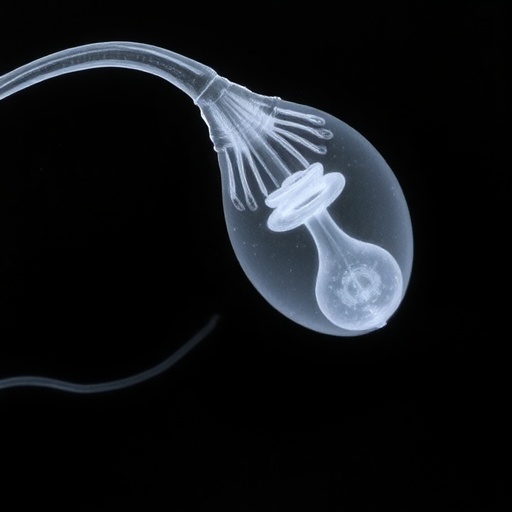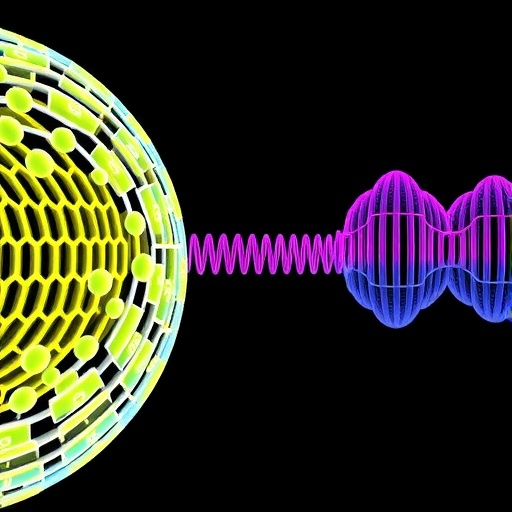
Recent advancements in reproductive science have unveiled compelling insights into the preservation of male fertility, particularly through the lens of cryopreservation. The process of freezing sperm has transformed assisted reproductive technologies, enabling countless individuals to store and later use viable sperm for conception. Nonetheless, the challenge of cryopreservation damage, which can severely impair sperm functionality, has raised concerns among researchers and clinicians alike. A groundbreaking study authored by Fu, Wang, and Li sheds light on this issue and proposes a potent solution through the use of piceatannol, a natural compound renowned for its protective properties.
Piceatannol, a polyphenolic compound primarily found in fruits such as grapes and berries, has garnered attention for its bioactive properties. In the context of reproductive biology, its role has emerged as a potential game changer for improving sperm quality during and after the cryopreservation process. The research team, led by Fu, conducted a series of experiments aimed at understanding the mechanisms through which piceatannol safeguards sperm from the deleterious effects of freezing and thawing. Their findings reveal that piceatannol operates by modulating the Keap1-Nrf2/ARE signaling pathway, a critical regulatory pathway known for its protective response against oxidative stress.
Oxidative stress has long been recognized as a primary culprit in sperm damage during cryopreservation. Freezing and thawing sperm can induce the formation of reactive oxygen species (ROS), which can lead to cell membrane damage, DNA fragmentation, and overall loss of sperm viability. As such, the exploration of antioxidants like piceatannol has become a focal point in efforts to mitigate these damaging effects. The study compellingly demonstrates how piceatannol exerts its antioxidant effects by enhancing the activation of Nrf2 (nuclear factor erythroid 2-related factor 2), a transcription factor that orchestrates the expression of a battery of protective genes.
Through a carefully designed experimental framework, the authors evaluated the impact of piceatannol on sperm parameters post-cryopreservation. These included motility, viability, and the integrity of the sperm DNA. The results were nothing short of remarkable; sperm treated with piceatannol exhibited significantly enhanced motility and higher rates of viability compared to untreated counterparts. Furthermore, there was a marked reduction in DNA fragmentation, underscoring the compound’s potential in preserving the genetic integrity of sperm cells.
What sets this research apart is its focus on a natural compound, aligning with a growing trend towards using botanical therapeutics in clinical settings. Unlike synthetic antioxidants, piceatannol derives from natural sources, making it a more appealing option for reproductive medicine practitioners. The integration of natural compounds into cryopreservation protocols could not only improve outcomes for patients but may also decrease side effects associated with synthetic alternatives.
The implications of this study extend beyond the laboratory. For individuals facing fertility challenges, particularly those requiring sperm banking for future use, the application of piceatannol represents a promising advancement. As fertility preservation becomes increasingly pertinent in today’s society—due to factors such as delayed parenthood, medical conditions, and personal choice—the demand for effective cryopreservation techniques has surged. Research findings, such as those from Fu et al., offer hope for improving the efficacy of these techniques, ultimately enhancing the chance of successful conception down the line.
Moreover, the significance of this research is compounded by the mounting evidence linking oxidative stress with various reproductive disorders. By demonstrating that piceatannol can ameliorate cryopreservation-induced damage, this study may catalyze further investigations into its potential applications beyond sperm preservation. Future studies could explore its effects on oocytes and embryos, thus broadening the understanding of oxidative stress in the reproductive context.
As the field of reproductive science continues to evolve, innovative solutions to age-old problems are paramount. The research conducted by Fu, Wang, and Li embodies this innovative spirit, incorporating a nuanced understanding of biological mechanisms while providing tangible solutions to pressing challenges. By harnessing the power of natural ingredients like piceatannol, researchers and clinicians can work together to sculpt a future where reproductive technology is more effective and accessible.
The study highlights another critical aspect of modern reproductive science: the importance of personalized medicine. As we unlock the intricacies of individual genetic and biological responses to treatments, tailored approaches in fertility preservation could become the norm. The promise held by antioxidants like piceatannol paves the way for customized cryopreservation protocols that cater to individual needs, enhancing the holistic approach to reproductive health.
In conclusion, the contributions made by the study on piceatannol and its protective role during sperm cryopreservation mark a significant step forward in reproductive science. This research not only adds a vital piece to the puzzle of sperm viability under freezing conditions but also paves the way for subsequent studies that investigate the broader anticancer, anti-inflammatory, and antioxidant roles of piceatannol. As scientists and practitioners delve deeper into the potential applications of piceatannol and similar compounds, the hope remains that these natural substances will provide the breakthroughs needed to address the challenges of fertility and reproductive health.
As this exciting field of research progresses, the ongoing exploration of biological pathways and natural compounds will likely yield even more innovative strategies to optimize reproductive outcomes. With a solid foundation now set through studies like this one, the future of male fertility preservation appears to be not just a possibility but an exciting reality. As these groundbreaking discoveries circulate through scientific communities and medical practices, couples facing fertility challenges may soon benefit from improved outcomes, underscoring the crucial intersection between research and real-world impacts.
In navigating the complexities of fertility, the findings on piceatannol represent a beacon of hope towards enhancing reproductive health. The dialogue between science and clinical practice is critical in ensuring that such discoveries translate seamlessly into effective treatments. As we anticipate future advancements inspired by these findings, both researchers and patients stand to gain from the ongoing commitment to understanding and improving fertility preservation practices.
With this robust groundwork laid, the future research directions surrounding piceatannol and the Keap1-Nrf2/ARE pathway hold great potential. The adaptability of biocompatible compounds may well navigate the landscape of reproductive medicine, offering new functionalities that could harness the body’s natural defenses against oxidative damage. In facing the age-old challenge of preserving fertility, the innovations spawned from intricate biological research highlight the exciting possibilities as science continues to unveil nature’s myriad of solutions.
In summary, the narrative surrounding piceatannol’s role in mitigating cryopreservation damage captures the essence of modern scientific inquiry intertwining with practical applications. Each study reaffirms the importance of understanding and harnessing natural mechanisms to secure a healthier future for reproductive health, ensuring that the emerging generations have robust solutions to fertility challenges.
Subject of Research: Effects of Piceatannol on Sperm Cryopreservation
Article Title: Correction: Piceatannol Protects Sperm from Cryopreservation Damage by Modulating the Keap1-Nrf2/ARE Signaling Pathway
Article References:
Fu, L., Wang, C., Li, W. et al. Correction: Piceatannol Protects Sperm from Cryopreservation Damage by Modulating the Keap1-Nrf2/ARE Signaling Pathway.
Reprod. Sci. (2025). https://doi.org/10.1007/s43032-025-01961-0
Image Credits: AI Generated
DOI:
Keywords: Piceatannol, sperm cryopreservation, oxidative stress, Keap1-Nrf2 pathway, reproductive health, fertility preservation, antioxidants
Tags: advancements in reproductive sciencebioactive compounds in reproductive healthcryopreservation damage in spermeffects of cryopreservation on sperm viabilityfreezing sperm technologyimproving assisted reproductive technologiesKeap1-Nrf2/ARE signaling pathwaymale fertility preservation techniquesnatural compounds for sperm qualityoxidative stress and sperm functionalityPiceatannol and sperm cryopreservationprotective properties of piceatannol




